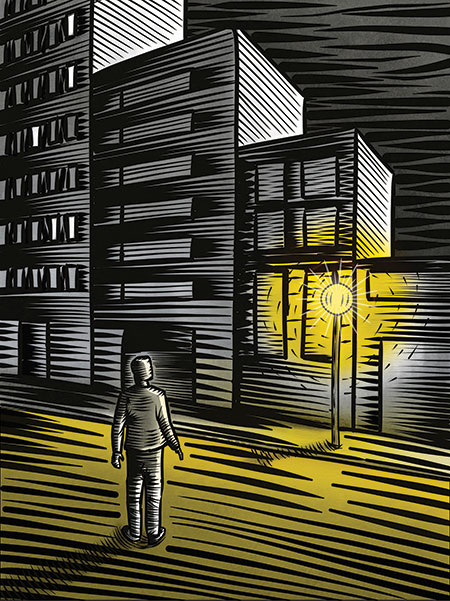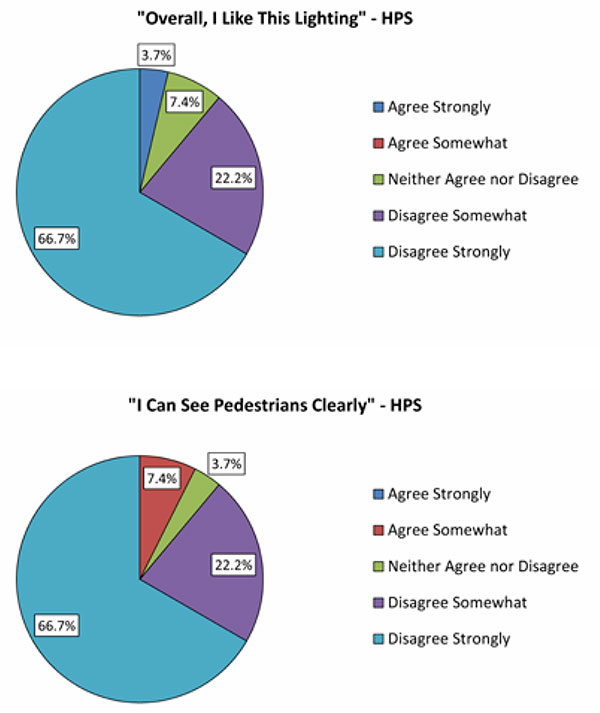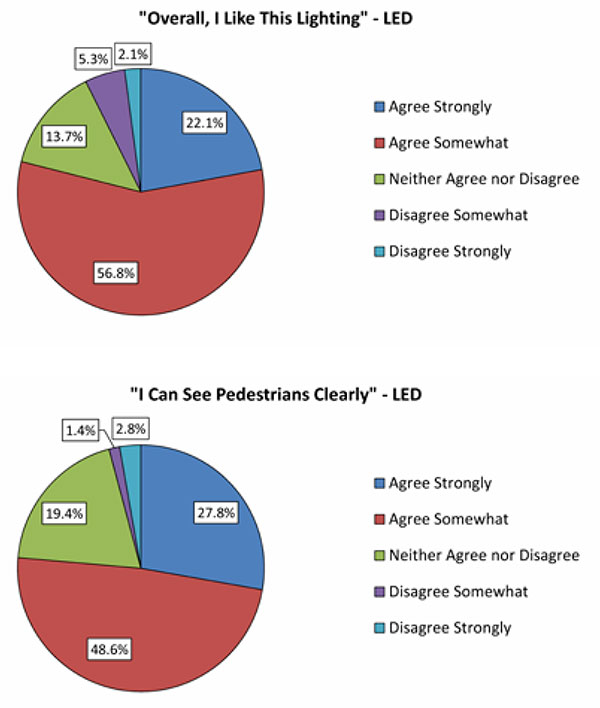And hello LEDs. The LRC recently managed a retrofit of high-pressure sodium streetlights outside Albany, NY, which also explored the economics of utility-owned street lighting
By John D. Bullough
 We know light emitting diode (LED) sources are not only technologically suitable for street and outdoor lighting,1 but in fact, despite some misgivings, LEDs are often preferred by municipalities over high pressure sodium (HPS) sources, for several reasons:
We know light emitting diode (LED) sources are not only technologically suitable for street and outdoor lighting,1 but in fact, despite some misgivings, LEDs are often preferred by municipalities over high pressure sodium (HPS) sources, for several reasons:
- LEDs use substantially less energy than HPS lighting systems
- LEDs have longer useful operating lives than HPS light sources
- LED luminaires can have better optical control than those using HPS lamps, potentially resulting in greater application efficacy2 or uniformity3
- LED-lighted outdoor spaces look brighter and feel safer than those illuminated by HPS4
- Many LED outdoor luminaires are readily equipped for dimming and adaptive control5
A few years ago, the New York State Department of Transportation (NYSDOT) wanted to investigate the feasibility of LEDs for illuminating highways and roads in New York State while reducing energy costs. Photometric and economic analyses revealed that there were multiple LED options for simultaneously improving visual conditions while still saving energy,1 and the American Association of State Highway and Transportation Officials (AASHTO) named the study one of its “sweet sixteen” high-value transportation research projects in 2017. With an assist from Elton John, here we explain how one project played out.
Central Avenue’s All Right for Lighting.
One of the roadways evaluated in that study was Central Avenue, a state highway and a major arterial roadway in the town and village of Colonie, NY, a suburb of the state’s capital city of Albany. NYSDOT, in partnership with the New York State Energy Research and Development Authority (NYSERDA), awarded the Lighting Research Center (LRC) at Rensselaer Polytechnic Institute a contract to oversee a retrofit of about 150 HPS streetlights to LED along a 3.4-mile stretch of this road. In addition to NYSERDA, NYSDOT, and the town and village, other partners supporting the project through co-funding and cost-sharing were the University Transportation Research Center (UTRC), the local electric utility (National Grid) and the Capital District Transportation Committee (CDTC).
The previous HPS lighting along Central Avenue was installed in the 1980s, when the amounts of commercial development and vehicle and pedestrian traffic were much lower than they are today. The HPS luminaires were mounted on existing utility poles on both sides of the road. Because of the large number of driveways and cross streets, the lighting layout was not especially regular, but a typical spacing between luminaires on each side of the road is about 200 ft in a generally staggered formation. Central Avenue has developed a reputation as problematic for pedestrian safety, and engineering firm Creighton Manning recently completed a pedestrian safety study6 for NYSDOT listing improved lighting as one potential measure that can help reduce pedestrian crashes. Creighton Manning collaborated with the LRC on the present lighting retrofit study.
The HPS lighting on Central Avenue, like most municipal street lighting, was leased by the town and village from the local electric utility, with a flat monthly fee covering the costs of purchasing and installing street lights, maintenance and replacement when lights burn out, and the energy charges to power the lights at night. Many organizations, including the New York State Office of the Comptroller,7 have touted municipal ownership of street lighting as a key cost-saving measure for local governments. However, few cities, towns and villages have large cash reserves on hand, so purchasing and then maintaining their street lighting systems is not an easy decision to make. One of the objectives of the present project, therefore, was to investigate the economics of utility-owned LED street lighting.
(Foot)candles in the Wind.
The project kicked off with a survey of members of the public who use Central Avenue about the existing lighting conditions. The wattages of the HPS luminaires ranged from 70 to 400 watts along the road, producing an average horizontal illuminance along the roadway of approximately 1.2 footcandles, with just under 0.9 footcandles in crosswalks, and between 0.4 and 0.9 fc on several sidewalks. In agreement with NYSDOT’s pedestrian safety study,6 survey respondents were less than impressed with the quality of the lighting on this road, whether they were responding as drivers or as pedestrians (Figure 1).

under HPS lighting.
Building on the previous feasibility study,1 the project stakeholders including NYSDOT and the town and village leadership wanted to improve the lighting conditions along Central Avenue through a retrofit of the HPS lighting, while (hopefully) saving energy and reducing overall costs. The project team performed photometric analyses of many different LED luminaires and the top three performers were each chosen to illuminate a portion of the roadway. For one of the LED luminaires, streetlights with correlated color temperatures (CCTs) of 3000K and 4000K were selected, and for the others, a CCT of 4000K was used. LED wattages ranged from 95 to 273 watts. As part of its support of the project, the electric utility purchased all of the LED luminaires, removed the existing HPS luminaires, and installed the LEDs as indicated by the project team.
One significant barrier that municipalities might experience when converting utility-owned HPS street lighting to LED is a requirement to reimburse the utility for the remaining value that the existing lights may have. Normally, electric utilities spread costs of street lighting across a long period of time that may exceed 20 years, so that equipment, maintenance and energy costs can be converted into a flat monthly charge. If existing HPS lights will be retrofitted with LEDs, those existing lights may have substantial “life” in them that the utility is required to recover. The HPS lights on Central Avenue were valued at over $20,000—an amount that the town and village would have had to pay, but which was covered by project funds from NYSERDA and NYSDOT. Municipalities interested in utility-owned LED street lighting should inquire about these types of charges as part of their preparations.
Hold Me Closer, Shine Enhancer.
When the LEDs were installed along Central Avenue in early 2019, they produced an average horizontal illuminance of 1.8 fc on the roadway (an increase of about 40%), with a 15% increase in crosswalks, and a 16% to 25% increase in the illuminance on the sidewalks. Interestingly, the increases along the pedestrian areas were not as large as those in the roadway itself, which may be related to their optical design, possibly optimized to illuminate the roadway surface.
Overall, and perhaps surprisingly, there were few differences noted among the different LED luminaire types that were installed. A survey of road users following the LED installation showed that the lighting in all of the LED-lighted sections was preferred over the previous HPS lighting (Figure 2), but there were very little differences reported among the different LED luminaires. The differences in appearance from the HPS luminaires may have been too large for people to be sensitive to the smaller differences among the LEDs, even between LEDs with different CCTs. Most people were unaware that the 3000K lights differed at all from any of the 4000K lights, despite the intense interest CCT gets in the lighting literature.

under LED lighting.
Even though the light levels along this part of Central Avenue were increased, the LED streetlights collectively use about 34% less energy than the HPS lights they replaced, meeting the objective of doing more (in terms of lighting and visual conditions) with less (energy). However, the cost savings that were realized for the town and village were not as large—less than 5%. This, of course, reflects the reality that LED street lighting systems are still relatively expensive in terms of initial costs. It should be noted, though, that the light levels in the retrofit installation were planned to be higher than those from the original lights; if the objective had been to match the existing lighting conditions, the energy and cost savings would have both been higher. Overall, though, this project helped to demonstrate the challenges and opportunities involved with utility-owned LED retrofit street lighting.
References for a Friend/Love Lies Reading
1 Bullough JD et al. 2015. Analysis of Energy Efficient Highway Lighting Retrofits, C-14-12. Albany: NYSDOT.
2 Freyssinier JP, Radetsky LC. 2011. ASSIST Recommends: Recommendations for Evaluating Street and Roadway Luminaires. Troy: Lighting Research Center.
3 Bullough JD et al. 2019. Integrating research on safety perceptions under parking lot illumination. Proc. CIE 29th Session, Washington.
4 Rea MS et al. 2017. Parking lot lighting based upon predictions of scene brightness and personal safety. Lighting Res. Technol. 49: 293.
5 CLTC. 2014. Adaptive LED Street and Area Lighting. Davis: University of California.
6 Creighton Manning. 2014. NY Route 5 Comprehensive Pedestrian Safety Study. Albany: NYSDOT.
7 Office of the Comptroller. 2007. Street Lighting Cost Containment. Albany: NYS Office of the Comptroller.

